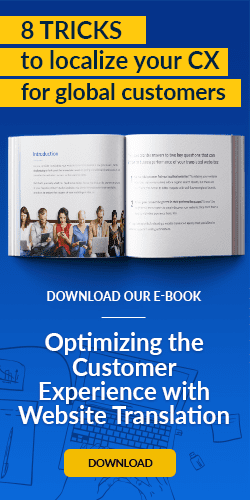Localizing your flagship transactional website for global markets is more than a smart marketing and PR move. It's a sure-fire way to increase international market share and brand recognition.
The Game Has Changed
E-commerce and online transactional experiences have come a long way in the past 20 years, especially when it comes to global markets. If you're not speaking their language, you're doing it wrong-and your company is probably suffering in the process.
Back in the ’90s, about 80% of all the Internet’s content was published in English. Thanks to mature tech and telecom infrastructures, U.S. and UK companies dominated the web with English content and shopping experiences.
Twenty years ago, 80% Internet content was published in English. Today, it's less than half that.
Today, experts believe the proportion of online English-language content is less than 40%. The growth of English-language content is greatly outpaced by Arabic, Russian, Chinese and Spanish. One expert suspects the number of native English-speaking online is less than 25%.
Understanding Global Customers’ Needs
Widespread and affordable Internet access may be a relatively new phenomenon in emerging markets, but that doesn't mean those customers have unsophisticated expectations for their online shopping experiences. These local users expect the same robust UX you offer customers on your flagship website.
Meet your global customers:
#1: They’re Using Regional Search Engines
Be it international instances of Google’s search engine, or locally-preferred search sites like Yandex (for Russia) or Baidu (for China), your global customers are using regional search engines to find products and services. And they’re searching in their languages, not yours.
(In fact, in global markets, Google makes it harder for customers to search in languages other than their native tongue.)
If your website isn’t optimized for organic search in those markets, you’re blowing it. This includes implementing international SEO best practices, including hreflang and global sitemaps. These help bestow the search-engine authority of your primary-market website to your translated sites, and fast-tracks them to higher SERP rankings.
If your global sites aren’t leveraging global SEO best practices, you’re blowing it.
#2: They Expect to Transact In Their Language
This is worth repeating: If they can’t read your site, global customers won’t transact there. This is even common in mature markets where English fluency is quite high.
One 2011 study indicated that nine out of 10 European online consumers always shop on websites in their own language. Nearly one in five said they never visit websites in languages that aren’t available in their language. And nearly half said they never purchase products and services in other languages.
#3: They Expect Content Parity
Global customers don't want to feel like second-class citizens when they visit your website. Offering them a compromised experience-presented via a website with untranslated content, or "mixed language" content, or a shallow microsite with comparatively little content-will confuse and offend customers.
Customers consistently abandon these sites, leading to low site traffic, limited social engagement and rock-bottom conversion rates. That cripples your chances of growth in new markets.
It’s risky to offer sites with untranslated content, “mixed language” content, or shallow microsites.
#4: They Expect Local Payment Support
Customers in different regions have different regionally-preferred payment methods. Offering MasterCard, Visa and PayPal in global markets will resonate with only a certain percentage of customers.
Offering locally-supported options-such as the Netherlands' iDeal, Germany's Giropay and Sweden's Klarna-increases the quantity of on-site sales. Supporting these payment platforms also builds in-market brand credibility. For instance, 75% of Germans prefer not to use credit cards when shopping online. Supporting alternate platforms boosts sales-and your brand's trustworthiness.
#5: They’re Transacting On Their Phones
Smartphone adoption, especially in emerging markets, continues to skyrocket. Cater to these mobile-first multilingual customers with your online experiences.
It’s not enough to make them mobile-friendly with responsive design. You need to localize your site’s SEO-rich structured data, to offer locally-relevant company information when customers conduct searches on their mobile phones.
Using a keyword strategy optimized for mobile-first global customers users is critical, too. Just like you, global customers use informal terms in their mobile-based searches. Your mobile SEO strategy should lean into that.
To be relevant in global markets, you must cater to mobile-first customers.
What To Do
If you want to capitalize on the game-changing opportunity of global e-commerce, you must adapt your approach and translate your website for your international markets’ preferred languages.
But localizing websites, and implementing best practices to cater to global customers' needs, is more challenging than you might think. When done internally or poorly, it's rife with continuous effort and hidden expenses, and slow entry into new markets.
Find a website vendor that can bring order to technical and operational chaos, and relieve you from the daily headaches of website localization. Look for turn-key solutions that handle the under-the-hood complexities that make website translation a burden for your IT and marketing team.
<ther approach,="" and="" ensure="" you="" have="" as="" much="" involvement="" control="" over="" the="" project="" wish.
Последнее обновление: 13 ноября 2017 г.
